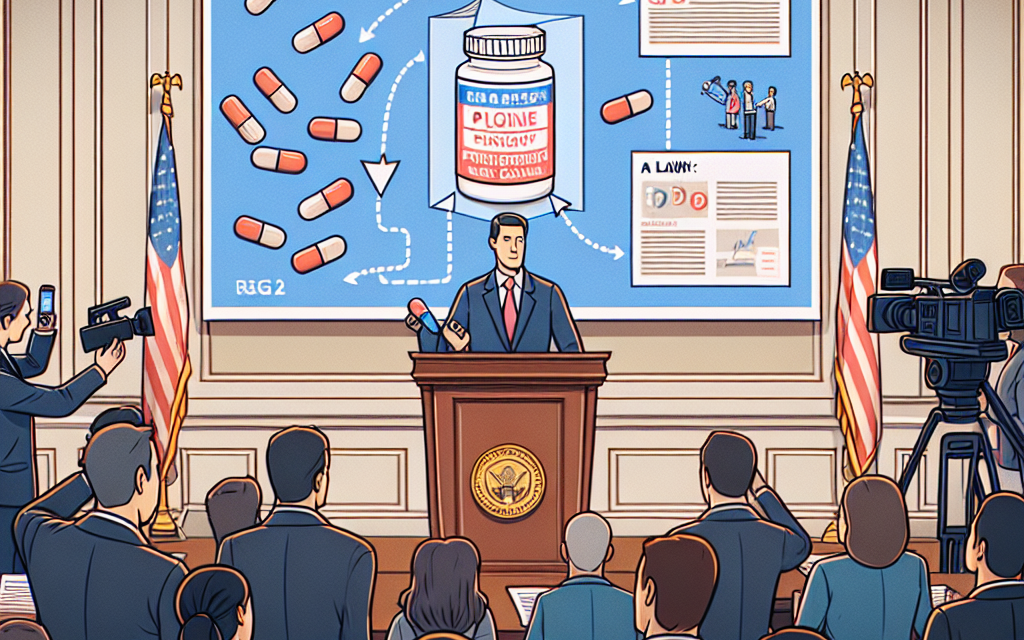Trump Unveils Strategy to Tackle Drug Pricing Law’s ‘Pill Penalty’
In recent years, the issue of drug pricing has become a focal point in American healthcare discussions. The rising costs of prescription medications have led to significant public outcry, prompting lawmakers and political figures to seek solutions. One of the most controversial aspects of drug pricing legislation is the so-called “pill penalty,” a term that refers to the financial burdens imposed on patients and healthcare providers due to high drug prices. In this article, we will explore former President Donald Trump’s strategy to address this issue, examining its implications, potential effectiveness, and the broader context of drug pricing in the United States.
Understanding the ‘Pill Penalty’
The term “pill penalty” encapsulates the financial strain that high drug prices place on patients, healthcare providers, and the healthcare system as a whole. This penalty manifests in various ways, including increased out-of-pocket costs for patients, higher insurance premiums, and the overall burden on public health systems.
The Financial Burden on Patients
For many Americans, the cost of prescription medications can be staggering. According to a report from the Kaiser Family Foundation, nearly one in four Americans has reported difficulty affording their medications. This financial burden can lead to several adverse outcomes:
- Medication Non-Adherence: Patients may skip doses or forgo medications altogether due to cost, leading to worsened health outcomes.
- Increased Emergency Room Visits: When patients cannot afford their medications, they may experience complications that require emergency care, ultimately increasing healthcare costs.
- Financial Strain: High drug prices can lead to significant financial strain, forcing patients to make difficult choices between medications and other essential expenses.
These factors contribute to a cycle of poor health outcomes and increased healthcare costs, highlighting the urgent need for reform in drug pricing.
The Impact on Healthcare Providers
Healthcare providers also feel the effects of high drug prices. Physicians and hospitals often face challenges in prescribing necessary medications due to cost considerations. This can lead to:
- Limited Treatment Options: Providers may avoid prescribing certain medications due to their high costs, limiting treatment options for patients.
- Increased Administrative Burden: Providers often spend significant time navigating insurance coverage and prior authorization processes, which can delay patient care.
- Financial Strain on Healthcare Systems: High drug prices can lead to increased costs for hospitals and clinics, impacting their financial viability.
These challenges underscore the need for a comprehensive strategy to address the pill penalty and its far-reaching consequences.
Trump’s Proposed Strategy
In response to the growing concerns surrounding drug pricing, former President Trump unveiled a multi-faceted strategy aimed at tackling the pill penalty. His approach includes several key components designed to reduce drug costs and improve access to necessary medications.
Price Transparency Initiatives
One of the cornerstones of Trump’s strategy is the push for greater price transparency in the pharmaceutical industry. By requiring drug manufacturers to disclose prices upfront, patients and providers can make more informed decisions about their healthcare. Key elements of this initiative include:
- Mandatory Price Disclosures: Drug manufacturers would be required to disclose the list price of medications in advertisements and at the point of sale.
- Public Price Databases: The creation of public databases that allow patients to compare prices across different pharmacies and providers.
- Incentives for Price Negotiation: Encouraging healthcare providers to negotiate prices with pharmaceutical companies to secure better deals for patients.
Price transparency is expected to empower patients and providers, enabling them to make more informed choices and potentially driving down costs through competition.
Encouraging Generic Drug Use
Another significant aspect of Trump’s strategy is the promotion of generic drugs as a means to reduce overall drug costs. Generic medications are typically much cheaper than their brand-name counterparts, and increasing their use can lead to substantial savings. Key components of this initiative include:
- Streamlined Approval Processes: Simplifying the regulatory process for generic drug approvals to encourage more competition in the market.
- Education Campaigns: Launching campaigns to educate patients and providers about the benefits of generic medications.
- Incentives for Prescribing Generics: Providing financial incentives for healthcare providers to prescribe generic medications when available.
By fostering a greater reliance on generics, Trump’s strategy aims to lower drug costs and improve access to essential medications for patients.
Negotiating Drug Prices
One of the most contentious aspects of drug pricing reform is the negotiation of drug prices between the government and pharmaceutical companies. Trump’s strategy includes provisions for allowing Medicare to negotiate prices directly with drug manufacturers. This approach has several potential benefits:
- Lower Prices for Seniors: By negotiating prices, Medicare could secure lower costs for prescription medications, benefiting millions of seniors who rely on the program.
- Increased Competition: Allowing negotiation could encourage pharmaceutical companies to lower prices to remain competitive in the market.
- Cost Savings for Taxpayers: Lower drug prices could lead to significant savings for taxpayers funding Medicare and Medicaid programs.
While this proposal has garnered support from various stakeholders, it has also faced opposition from pharmaceutical companies concerned about potential impacts on innovation and research funding.
Addressing Pharmacy Benefit Managers (PBMs)
Pharmacy Benefit Managers (PBMs) play a crucial role in the drug pricing landscape, acting as intermediaries between insurers, pharmacies, and drug manufacturers. Trump’s strategy includes measures to increase transparency and accountability among PBMs. Key elements of this initiative include:
- Eliminating Spread Pricing: Prohibiting PBMs from using spread pricing, where they charge insurers more for a drug than they reimburse pharmacies, leading to inflated costs.
- Requiring Disclosure of Rebates: Mandating that PBMs disclose the rebates they receive from drug manufacturers, allowing for greater transparency in pricing.
- Encouraging Competition: Promoting competition among PBMs to drive down costs for consumers.
By addressing the role of PBMs in the drug pricing ecosystem, Trump’s strategy aims to create a more transparent and competitive market that benefits patients and providers alike.
Expanding Access to Importation of Drugs
Another significant component of Trump’s strategy is the expansion of access to imported drugs from other countries, particularly Canada. This approach aims to provide patients with access to lower-cost medications while maintaining safety and efficacy. Key aspects of this initiative include:
- Streamlined Importation Processes: Simplifying the regulatory framework for importing drugs from Canada and other countries with lower prices.
- Safety Regulations: Ensuring that imported drugs meet safety and efficacy standards to protect patients.
- Public Awareness Campaigns: Educating patients about the benefits and safety of accessing imported medications.
By allowing patients to access lower-cost medications from abroad, Trump’s strategy seeks to alleviate some of the financial burdens associated with high drug prices.
Potential Challenges and Criticisms
While Trump’s strategy to tackle the pill penalty presents several promising initiatives, it is not without its challenges and criticisms. Understanding these potential obstacles is crucial for evaluating the effectiveness of the proposed reforms.
Resistance from Pharmaceutical Companies
One of the most significant challenges facing Trump’s strategy is the potential resistance from pharmaceutical companies. The industry has historically opposed measures that could impact their profit margins, and many companies argue that price negotiations could stifle innovation. Key concerns include:
- Impact on Research and Development: Pharmaceutical companies argue that lower prices could reduce the funds available for research and development of new drugs.
- Job Losses: The industry warns that price controls could lead to job losses in the pharmaceutical sector, impacting the economy.
- Legal Challenges: Pharmaceutical companies may pursue legal action against any measures they perceive as infringing on their rights or profitability.
Addressing these concerns will be essential for garnering support for Trump’s proposed reforms.
Implementation Challenges
Implementing a comprehensive drug pricing strategy is fraught with challenges. The complexity of the healthcare system, coupled with the diverse interests of stakeholders, can complicate the rollout of reforms. Key implementation challenges include:
- Coordination Among Stakeholders: Ensuring that all stakeholders, including insurers, providers, and pharmaceutical companies, are on board with the proposed changes.
- Regulatory Hurdles: Navigating the regulatory landscape to implement new policies can be time-consuming and complex.
- Public Awareness: Educating the public about new initiatives and how they can benefit from them is crucial for successful implementation.
Overcoming these challenges will require a concerted effort from policymakers and stakeholders alike.
Potential Unintended Consequences
While the proposed reforms aim to lower drug prices and improve access, there is a risk of unintended consequences that could arise from their implementation. These may include:
- Reduced Access to Innovative Treatments: If pharmaceutical companies reduce investment in research due to lower profits, patients may have less access to innovative treatments.
- Market Disruptions: Rapid changes in pricing structures could lead to market disruptions, impacting the availability of certain medications.
- Increased Costs in Other Areas: Efforts to lower drug prices may lead to increased costs in other areas of healthcare, such as insurance premiums or provider fees.
Policymakers must carefully consider these potential consequences when designing and implementing drug pricing reforms.
Case Studies and Examples
To better understand the implications of Trump’s strategy to tackle the pill penalty, it is essential to examine case studies and examples from other countries and initiatives that have attempted similar reforms.
Case Study: Canada’s Drug Pricing Model
Canada’s approach to drug pricing offers valuable insights into potential strategies for the United States. The country employs a combination of price controls and negotiation strategies to keep drug costs manageable. Key features of Canada’s model include:
- Patented Medicine Prices Review Board (PMPRB): This independent agency regulates the prices of patented medications, ensuring they are not excessive compared to international benchmarks.
- Public Drug Plans: Many Canadians have access to public drug plans that cover a significant portion of their medication costs, reducing out-of-pocket expenses.
- Negotiated Pricing: Provincial governments negotiate prices with pharmaceutical companies, leveraging their purchasing power to secure lower costs.
Canada’s model demonstrates that a combination of regulation and negotiation can lead to lower drug prices while maintaining access to necessary medications.
Case Study: The Veterans Affairs (VA) System
The U.S. Department of Veterans Affairs (VA) provides another example of a successful drug pricing model. The VA negotiates prices directly with pharmaceutical companies, resulting in significantly lower costs for veterans. Key aspects of the VA’s approach include:
- Bulk Purchasing: The VA’s large patient population allows it to negotiate bulk purchasing agreements, leading to lower prices.
- Formulary Management: The VA employs a formulary system that prioritizes cost-effective medications, ensuring that veterans have access to affordable treatments.
- Transparency in Pricing: The VA’s pricing structure is transparent, allowing veterans to understand the costs associated with their medications.
The VA’s success in negotiating drug prices highlights the potential benefits of direct negotiation strategies in reducing costs for patients.
Case Study: The European Union’s Approach
The European Union (EU) offers a diverse landscape of drug pricing strategies, with member countries employing various approaches to manage costs. Key features of the EU’s model include:
- Price Negotiation: Many EU countries negotiate drug prices directly with manufacturers, often resulting in lower costs compared to the U.S.
- Health Technology Assessment (HTA): Countries like Germany and France use HTA to evaluate the cost-effectiveness of new medications before determining their pricing.
- Reference Pricing: Some EU countries use reference pricing, setting prices based on the costs of similar medications in other countries.
The EU’s varied approaches demonstrate that there is no one-size-fits-all solution to drug pricing, but rather a range of strategies that can be tailored to specific healthcare systems.
Conclusion
Trump’s strategy to tackle the pill penalty represents a significant effort to address the pressing issue of drug pricing in the United States. By focusing on price transparency, promoting generic drug use, negotiating prices, addressing the role of PBMs, and expanding access to imported drugs, the proposed reforms aim to alleviate the financial burdens faced by patients and healthcare providers.
However, the strategy is not without its challenges. Resistance from pharmaceutical companies, implementation hurdles, and potential unintended consequences must be carefully navigated to ensure the success of these reforms. Additionally, examining case studies from other countries and systems provides valuable insights into potential strategies and outcomes.
Ultimately, addressing the pill penalty requires a comprehensive and collaborative approach that considers the diverse interests of stakeholders while prioritizing patient access to affordable medications. As the conversation around drug pricing continues, it is essential for policymakers to remain vigilant and responsive to the evolving landscape of healthcare in America.





